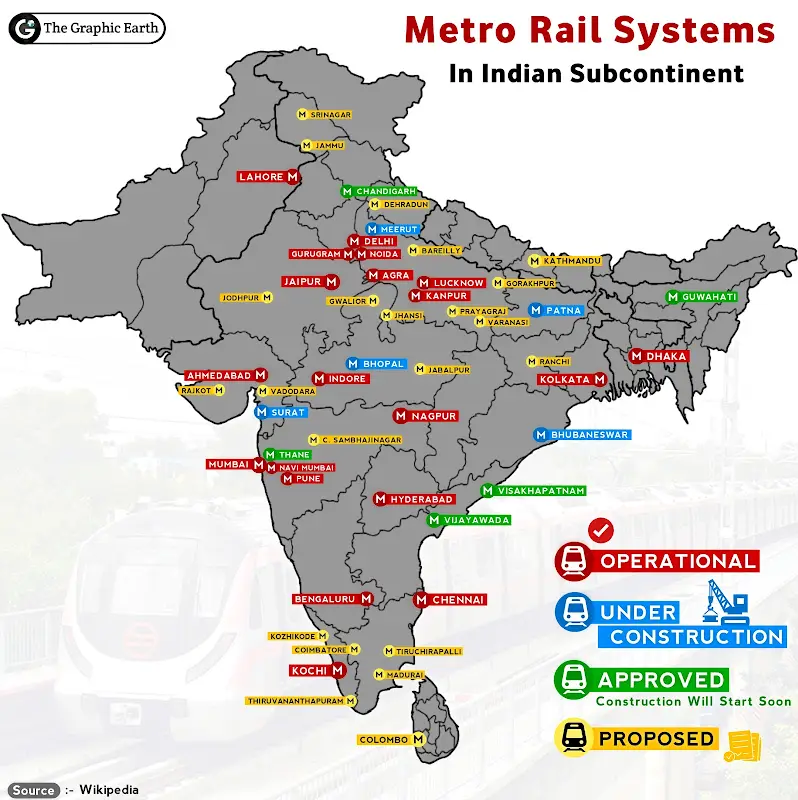Metro Railway Systems in Indian Subcontinent Map


David Chen
Data Visualization Specialist
David Chen is an expert in transforming complex geographic datasets into compelling visual narratives. He combines his background in computer science ...
Geographic Analysis
What This Map Shows
This visualization provides a comprehensive overview of the metro railway systems across the Indian subcontinent, highlighting the extensive network of urban transit systems that have transformed how people navigate major cities. Covering key metropolises such as Delhi, Mumbai, Kolkata, and Bangalore, the map not only illustrates the routes but also emphasizes the connectivity between various urban centers. Each line and station depicted represents a vital artery in the bustling life of these cities, showcasing the growth and expansion of urban transit.
Deep Dive into Metro Railway Systems
The metro railway systems in the Indian subcontinent have emerged as critical components of urban infrastructure, designed to mitigate traffic congestion and promote sustainable urban mobility. The first metro system in India was launched in Kolkata in 1984, paving the way for other cities to follow suit. Today, Delhi boasts one of the largest and most advanced metro systems in the world, with over 390 kilometers of track and more than 280 stations. Interestingly, the Delhi Metro's unique design incorporates energy-efficient technologies and has become a model for other cities.
Metro railway systems are not just about moving passengers; they play a significant role in urban development. The presence of a metro line often leads to increased real estate values and stimulates economic growth in surrounding areas. For example, areas around metro stations in Bangalore have witnessed remarkable development, with new commercial spaces, residential projects, and improved infrastructure enhancing the urban landscape.
Moreover, what's fascinating is how metro systems can significantly reduce the carbon footprint of urban transport. With a growing population, cities like Mumbai, which has one of the most congested road networks, are investing heavily in metro rail projects to provide a cleaner, more efficient alternative to traditional vehicles. The Mumbai Metro, which started operations in 2014, is expanding rapidly and aims to alleviate the stress on the city's roads.
Equally important are the socio-economic implications of these metro systems. They provide affordable transportation options for millions of daily commuters, helping to bridge the gap between different socio-economic classes. The introduction of women-only coaches in some metro systems like Delhi and Mumbai also reflects an effort to enhance safety and accessibility in public transport.
Regional Analysis
When we look at the metro systems across different regions in the Indian subcontinent, distinct patterns emerge. In Northern India, Delhi's metro serves as a backbone connecting various suburbs to the city center, while in Kolkata, the metro has been crucial for connecting the historical parts of the city with newer developments.
In Southern India, cities like Bangalore and Chennai are rapidly expanding their metro networks to cope with urban sprawl. The Bangalore Metro, known as Namma Metro, is still under construction, with new phases aimed at connecting areas that were previously inaccessible. On the other hand, Chennai's metro, which was inaugurated in 2015, is also expanding, although it has faced challenges related to funding and land acquisition.
Interestingly, the smaller cities are beginning to adopt metro systems as well. Cities like Kochi have implemented the Kochi Water Metro, which integrates water transport with existing metro lines, showcasing innovative approaches to urban mobility.
Significance and Impact
The significance of metro railway systems in the Indian subcontinent cannot be overstated. As urban populations continue to swell, the development of efficient public transport systems is vital for sustainable urban growth. These systems not only reduce traffic congestion but also contribute to lower pollution levels, making cities more livable.
Looking forward, trends indicate that metro systems will continue to expand, with increasing investments from both government and private sectors. Innovations in technology, such as automated trains and smart ticketing systems, are likely to enhance user experience and operational efficiency. Furthermore, with a focus on sustainability, future metro projects may increasingly incorporate green technologies, such as solar power and regenerative braking systems.
In conclusion, the metro railway systems in the Indian subcontinent are more than just transit solutions; they are pivotal to the urban fabric that supports economic growth, social inclusion, and environmental sustainability. As we move into the future, these networks will play an essential role in shaping the cities of tomorrow, providing hope for a more connected and sustainable urban lifestyle.
Visualization Details
- Published
- September 19, 2025
- Views
- 64
Comments
Loading comments...